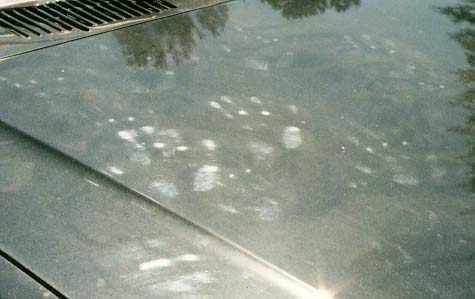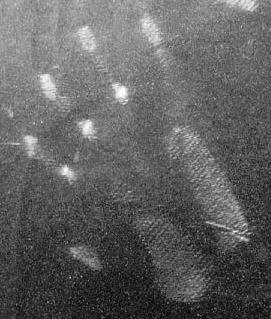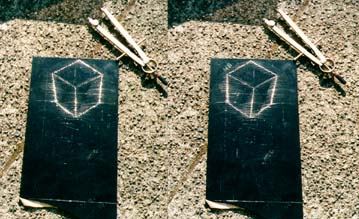I've stumbled across a technique for drawing holograms directly upon a plastic plate by hand. It sounds impossible, but I've been sitting on
the living room sofa making holographic images of floating polyhedra, words, 3D star fields, opaque objects, etc. No LASER, no isolation
table, no darkroom, no expensive film plates. This takes nothing more than a compass and some scraps of Plexiglas. Too cool, if I say so
myself! There's an interesting story behind this technique, but first, the instructions.
Obtain a small piece of acrylic plastic and a good, non-wobbly set of "dividers" (a compass with two points.) I used a $10 compass from an
art supply store and replaced the pencil lead with the supplied metal point. Next, use a marker to draw a simple pattern such as the letter
"V" near the lower edge of the plate. This will be the image that we'll encode onto the surface. Draw your "V" about ½ in. tall. Set the
spacing of the compass points to a couple of inches. Place one point on the tip of the "V", and gently drag the other point slowly across the
plastic so you make a scratch that looks something like the figure below. It helps to tilt the compass so the point trails across the surface and
does not dig in or chatter.
___________________________
| ____----____ | The scratch should be dark and polished, not white and dusty. It should show a small highlight when viewed in
| __/ \__ | sunlight or under a pointsource illuminator.
| / \ |
| | Now, while keeping the dividers at exactly the same spacing, place the point at many other locations on the "V"
| | and make another circular scratch for each one.
| |
| | Do this ten times or more. The result should look like you've swept a bit of sandpaper across the plastic plate.
| |
| |
| V |
| |
|___________________________|
To view the resulting image, observe the scratches in sunlight. If your plate is transparent it helps to place something black behind it or to
paint the back surface dark for contrast. While holding the plate chest-high with the little "V" towards your body, rotate yourself around
so you face the sun, tilt the plate up and down, and at a certain angle you will see a moving highlight in the scratches. The highlight is an
image of the letter "V." When viewed with both eyes open, the "V" seems to float deep within the plastic. Its virtual depth is determined by
the compass: if the spacing of the points was set to 1 in., the image appears 1 in. below the plastic surface.

Several hologram plates
Depending on the tilt of the plate with respect to the sun, you might accidentally discover the pseudoscopic image of the "V," and it may appear
to float *above* the surface of the plastic. Tilt the plate to bring the far edge up and towards you and you'll then find the orthoscopic image
floating deep within the plate.
If you had inscribed your entire name on the plastic, you'd now be seeing it down there within the surface. (hint hint!) It's also possible to draw
complicated 3D objects by varying the compass spacing as you slowly draw glowing lines one point at a time. I've been making cubes, pyramids, and
holes with glowing stars at the bottom. Just like with conventional holograms, opacity effects can be had by controlling the location of the
endpoints of the scratches. And many other sophisticated effects produced by conventional rainbow holography can be duplicated in black plastic and
scratch patterns.
CHANCE FAVORS THE *CURIOUS, PLAYFUL* MIND
All this all started while I was walking along the rows of cars in the parking lot at work. I noticed this one black station wagon hood that had
a number of glowing highlights created by the sunlight. Typical science hobbyist response: I stopped and began playing with them. I was moving my
head back and forth in order to make them slide around, when I noticed that some of the highlights seemed to exist a few inches WITHIN the
surface of the car hood. I've long been interested in stereo images, so I started examining these "deep" highlights in detail. Some of the larger
ones had an interesting structure, appearing as an 8 in. circular blotch of light with a radial pattern of filaments and a mottled central area.
All these highlight-patterns seemed identical, and were floating at various depths within the car hood.
 Car hood after polishing with a dirty paper towel
The handprints in the photo look like they're on the surface, but actually they appear to float about one foot deep within the surface of the hood.
With a start I suddenly I realized what I was seeing. It was incredible: each highlight was in the shape of a lambskin polishing mitt, with matted
wool in the center surrounded with outwards-pointing wooly filaments! The matted part was in the shape of a human hand! There were several of them
floating at various depths all over the car hood, with some of them even existing in the space *above* the hood. It wasn't long before I had half
the engineering department out there acting like fools, moving their heads back and forth in front of this black station wagon. I found several
other cars which also had glowing handprints deep within various surfaces.
Car hood after polishing with a dirty paper towel
The handprints in the photo look like they're on the surface, but actually they appear to float about one foot deep within the surface of the hood.
With a start I suddenly I realized what I was seeing. It was incredible: each highlight was in the shape of a lambskin polishing mitt, with matted
wool in the center surrounded with outwards-pointing wooly filaments! The matted part was in the shape of a human hand! There were several of them
floating at various depths all over the car hood, with some of them even existing in the space *above* the hood. It wasn't long before I had half
the engineering department out there acting like fools, moving their heads back and forth in front of this black station wagon. I found several
other cars which also had glowing handprints deep within various surfaces.

Close up of handprint pattern, 6" virtual depth
I proposed several crude theories to explain the phenomena, as well as numerous hoaxes which could be done via Elvis-shaped polishing mitts to
encode miraculous images onto everyday objects. (The Hood of Turin?) It was about a week before I figured out what was really going on. The
images were naturally-occurring holograms. The owner of the car had obviously polished the hood with a dirty mitt, and the millions of
particles of grit in the mitt traced out millions of nearly-parallel scratches in the black paint. The particular hand motion had created a
geometry of abrasion patterns which turn out to be nearly identical to the interference patterns which make up those embossed-foil Benton white
light rainbow holograms commonly found on credit cards.
But there was something extremely weird about the abrasion patterns on the hood (I mean even more weird than their causing images!) They seemed to
be functioning as holograms without the benefit of optical interference. This is impossible of course, since holography is completely based upon
interference effects. However, Benton's technique allows a hologram to function regardless of illumination frequency. The classic setup includes
a horizontal slit which produces large horizontal stripes of fine interference patterns on the film, and these encode the depth information
via varying orientation of the fringes across the stripe. Once I was clued in by the existence of the car-hood holograms, I realized that I could
also interpret Benton's technique as allowing holograms to function regardless of fringe spacing. Frequency independence leads to size
independence. The fringe spacing could be made random. Or it could be made very large.
No one seems to realize that the Rainbow Hologram technique lets you produce holograms which are not based on optical interference at all. It
makes possible the creation of holograms where the "fringes" are so large that they are easily seen by the naked eye. And if the arrays of
hyperbolic interference fringes in the hologram are replaced by widely-spaced hand-ruled scratches on a plastic plate, it becomes possible to draw
complicated holographic images directly by hand with a sharp tool. Multiple parallel scratches aren't necessarily required, and circles can replace
the hyperbolae. The circular-scratch technique is able to produce holographic images, and circular motions of gritty polishing mitts can produce
these holograms accidentally.

Hand-drawn cube hologram
(STEREO PAIR, Crosseyed viewing)
Has anyone heard of this trick before? I've yet to find it mentioned in any holography article or text. It's starting to look like this is
something new...
(AHA! The paper by Plummer & Gardner from 1992 (ref. below) details just such a discovery, with an analysis of reflections off the
arrays of circular scratches produced by the orbits of a lapping tool on a metal mirror. -Bill B., 10/23/95)
The technique might be very useful in reducing the amount of data required for computer-generated holography. The size-independence characteristic
suggests that billboard-sized holograms wouldn't be impossible to build. If an object is illuminated with structured light resembling a dense
random star field and photographed at 2f distance from a camera having a curved slit-aperture, it might be possible to use the technique to
accomplish LASERless holographic photography.
Conventional Rainbow Embossed holograms do trounce it badly in the brightness and sharpness categories, but conventional techniques won't let
you create a "physics demo" hologram with giant interference fringes easily viewed with the unaided eye. And conventional holography won't let
you sit by the side of a lake in Vermont with plexi and dividers, drawing holographic virtual images of floating polyhedra by hand.
- Bill Beaty
billb@eskimo.com
P.S. The required tools are so simple that primitive peoples could have drawn these images in hardened sooty resin pools with wooden tools had
they but known the trick. Several ancient civilizations were heavily into geometry. I wonder if any artifacts exist in storage somewhere which
appear to have some sandpaper marks on their polished surfaces... ;)
REFERENCES
W. Plummer & L. Gardner, Applied Optics, V.31 No.31, Nov. 1992, pp. 6585-6588,A mechanically generated hologram?,
F. S. Yu, A. Tal, H. Chen, Optical Engineering, Vol.19 No.5, pp. 666-678, "One-step rainbow holography: recent development and application."
H. Caulfield, National Geographic, Vol.165, No.3, p. 372
|

 Car hood after polishing with a dirty paper towel
The handprints in the photo look like they're on the surface, but actually they appear to float about one foot deep within the surface of the hood.
With a start I suddenly I realized what I was seeing. It was incredible: each highlight was in the shape of a lambskin polishing mitt, with matted
wool in the center surrounded with outwards-pointing wooly filaments! The matted part was in the shape of a human hand! There were several of them
floating at various depths all over the car hood, with some of them even existing in the space *above* the hood. It wasn't long before I had half
the engineering department out there acting like fools, moving their heads back and forth in front of this black station wagon. I found several
other cars which also had glowing handprints deep within various surfaces.
Car hood after polishing with a dirty paper towel
The handprints in the photo look like they're on the surface, but actually they appear to float about one foot deep within the surface of the hood.
With a start I suddenly I realized what I was seeing. It was incredible: each highlight was in the shape of a lambskin polishing mitt, with matted
wool in the center surrounded with outwards-pointing wooly filaments! The matted part was in the shape of a human hand! There were several of them
floating at various depths all over the car hood, with some of them even existing in the space *above* the hood. It wasn't long before I had half
the engineering department out there acting like fools, moving their heads back and forth in front of this black station wagon. I found several
other cars which also had glowing handprints deep within various surfaces.

